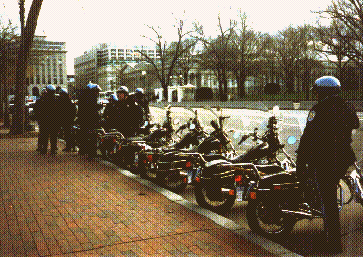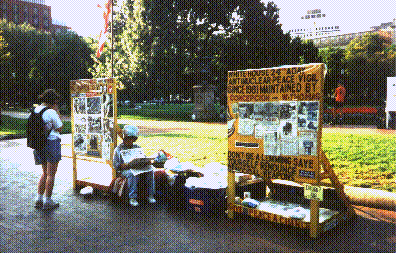
EL PAIS
Diario independiente de la semana
Redaccion Administrativa y talleres Miguel Yuste 40-28037 madrid-tl-{91}337-8300 80 pesetas- ano xv1 numero 5.083
Edicion Madrid
Sabado 2 de marzo de 1991
GENTE
CONCEPCION MARTIN

10 anos de protesta
ante la Casa Blanca
J.M. Washington.
Desde el 1 de agosto de 1981, unaa gallega de Vigo vive las 24 horas del dia en vigilia pacifista antinuclear frente a la Casa Blanca. Concepcion Martin Picciotto, de 46 anos, conocida como Connie, es la historia de una desesperacion personal que la llevo a expresar su impotencia istalandose con un fardo de ropas y una pancarta a a escasos metros del domicilio del presidente norteamericano. La acera del numero l.600 de la Pennsylvania Avenue, domicilio postal de la Casa Blanca, es tambien, desde hace 10 anos, el de esta gallega, nacionalizada norteamericana, atormentada por un drama familiar y hoy dispuesta a seguir su dramatica vigilia :hasta que Dios quiera.
Connie comparte con otro pacifista- Thomas Doubting-, vecino de pancarta unos metross al lado de su vigilia desde 1981. Los dos, Connie y Thomas, son los veteranos de una protesta que forma parte del paisaje turistico de uno de los lugares mas visitados de Washington, el parque de la Fayette, frente a la Casa Blanca. Concepcion llego a su vigilia pacifista, que dura ya 10 anos, despues de mover Roma con Santiago pidiendo ayuda para un dramatico problema personal: un tribunal de Manhattan le concedio la patria potestad de su hijita al marido, del que Concepcion acaba de divorciarse en 1974, un italo-norteamericano con el cual se habia casado cuando ella tenia 21 anos. Del tormentoso divorcio, la emigrante gallega perdio a su marido, a su hija, su trabajo y su casa. Y desde entonces no volvio a ver a su hija, que ahora tiene 17 anos.
"Yo queria irme a Espana para educar alli a mi hijita, pero mi marido y su familia se opusieron y montaron toda una campana de acoso hasta que acabaron quitandome la potestad de la nina. Dijeron que no era una madre adecuada", dice. "Aqui no hay justicia, todo es un negocio. Y yo fui una victima de este sistema corrompido. Aquello fue una injusticia y un acoso del sistema social norteamericano, que contra el que llevo luchando desde entonces, y asi seguire haciendolo hasta que Dios quiera"
Ayudada, tan generosa como inutilmente, por grupos religiosos y de derechos humanos, Connie comenzo un peregrinage por despachos politicos de Nueva York y Washington en busca de ayuda, que nunca obtuvo. En Madrid el Ministerio de Exteriores tampoco lwe fue muy util, ya que le dijeron, que habia perdido su nacionalidad espanola. Y cansada y mareada y enloquecida en su frustracion, un dia , en 1978, comenzo a expresar su protesta portando pancartas frente a la Casa Blanca. Luego, el I the agosto de 1981, siguio el ejemplo de un pacifista, Thomas Doubting que habia comenzado una vigilia pacifista permanente, y se instalo con el.. Desde entonces, sobreviven frente al acoso policial, las inclemencias del tiempo, las provocaciones de patriotas radicales y las agresiones de algun que otro loco que se acerca por alli. Las ordenanzas de Servicio de Parques y jardines, que custodia la zona, les prohiben dormir en sacos, sentarse en sillas o portar mas de una pancarta.. Tienen que permanecer unos metros separados el uno del otro, y sus pancartas no pueden tener mas de unas medidas estipuladas y que la policia se encarga de verificar a cada rato.
Concepcion, que vive de la ayuda de particulares y de los donativos que recibe cuando regala unas piedras de la paz pintadas por ella, reconoce resignada la dureza de su campana.
Me costo muchisimo ponerme aqui las 24 horas del dia. Es un sacrificio enorme, pero seguire hasta que Dios quiera.


 EL PAIS
EL PAIS 10 anos de protesta
10 anos de protesta 